Biacore X100 reference portal
Solvent correction procedure
Principle of solvent correction
Solvent correction values are determined by injecting blank samples containing a range of DMSO concentrations and plotting the difference in relative response on the ligand and reference spots against the relative response on the reference spot. Each sample measurement is then corrected by a factor obtained by measuring the relative response on the reference spot and reading the corresponding difference between ligand and reference spots from the curve.
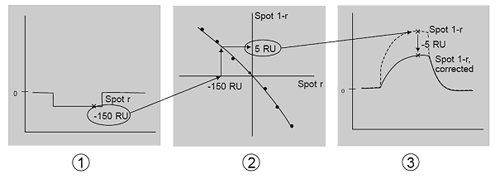
The principle of solvent correction. 1. The sensorgram from the reference spot shows a bulk displacement (-150 RU in the illustration) during sample injection because the sample and running buffer are not exactly matched. 2. From the solvent correction curve, a displacement of –150 RU in the reference sensorgram corresponds to a solvent error of +5 RU in the reference-subtracted sensorgram. 3. The reference-subtracted sensorgram is corrected by subtracting the solvent error. This procedure is applied to every point during sample injection.
In this procedure, the relative response on the reference spot provides a kind of empirical calibration of the DMSO concentration in the sample.
Solvent correction is applied only to response levels during sample injection, since the correction adjusts for differences in bulk response between different samples. The bulk response is constant before and after the injection, when running buffer is flowing over the surface, and correction is meaningless there.
Solvent correction cycles
Solvent correction cycles, typically 8 injections of solvent correction solutions per cycle, are repeated at intervals during the run.
Preparation of solvent correction solutions
Prepare all solutions containing DMSO fresh each day.
Regardless of how you prepare your solutions, it is essential that solvent correction solutions, samples and running buffer are all prepared from the same stock solutions using as far as possible the same dilution procedures. Any differences in preparation routines will introduce potential errors in the solvent correction procedure.
Lab protocols
Lab procedure Preparation of 4-point solvent correction and samples for binding assay in 2% or 5% DMSO, resp., is available for download on www.cytivalifesciences.com/solutions/protein-research/Interaction-analysis-with-Biacore-surface-plasmon-resonance-SPR/Get-started-with-surface-plasmon-resonance-SPR-interaction-analysis
Shape
The shape of the solvent correction curve depends on many different factors, for example ligand properties, immobilization level, detection unit characteristics, solvent correction range and so on. There is no “correct” shape for the curve: the quality of the curve is indicated by how well it fits to the data points.
The shape of the correction curve, measured using the same solutions on equivalent surfaces, may differ between individual instruments. This is normal and reflects slight differences in the detection unit characteristics between instruments. The differences do not in any way affect the accuracy or performance of the instruments.
Note the y-axis scale when judging curve shape. Auto-scaling of the display can exaggerate non-linear aspects of a correction curve that covers a narrow range on the y-axis:
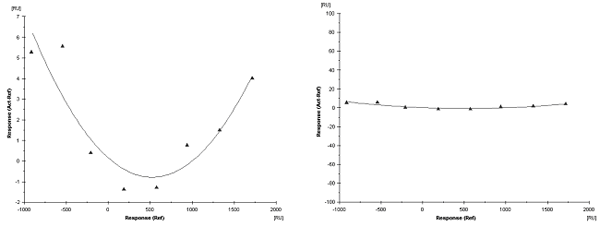
Position
An ideal correction curve should pass through zero on both axes.
If the salt concentration differs between the running buffer and the solvent correction solutions, samples with the same DMSO concentration as running buffer will give a reference-subtracted response that is not zero. This will displace the correction curves and introduce an offset in the corrected response values.
To minimize salt differences, all solutions should be prepared carefully from the same concentrated stock buffer and handled in the same way as far as possible.
Evaporation
Displacement of the solvent correction curve during the run could be caused by evaporation. Evaporation from vials results in increasing bulks while evaporation from running buffer results in decreasing bulks. Always use as full vials as possible to minimize the effects of evaporation. All vials should be capped immediately after preparation. The running buffer bottle should also be properly capped.

Evaporation from the solvent correction solutions shifts the solvent correction curve to the right.
Contamination
If one solution shows a drastic change in bulk it could be due to contamination from other solutions used in the instrument (for example wash solution). Contamination could be due to salt residues on the needle or if the distilled water bottle is empty. Accumulation of salt residues in the flow system and on the needle is prevented by following maintenance routines and by running standby between runs.

Contamination shifts single solvent correction points.
Unstable surface
The slope and shape of the curve depends on the difference in immobilized level between the reference spot and the immobilized spot. If ligand is lost from the immobilized spot, the difference between the surfaces is expected to decrease. Samples are always corrected using the closest correction curve before the sample. All changes in the surface between correction curves may affect the quality of the correction procedure. Correction curves should be run every 20 – 30 samples to assure valid correction of data.

Loss of ligand changes the slope of the curve.
Binding and precipitation
Irreversible binding or precipitation of samples on any spot will also change the correction curve. If a correction cycle is affected by for example precipitation it may be necessary to exclude the cycle. Samples affected by the precipitation should be re-tested. Using adaptive conditions for the samples can increase the stability and reduce effects on the correction curve.
Buffer refill
If buffer is added during the run there is a possibility that the difference between solvent correction solutions and the running buffer is altered. The effect can be seen as a change in the correction interval as well as a baseline shift. Always make sure if possible that there is sufficient buffer for the run. If buffer has to be refilled, make a note of the cycle where buffer was added. It will take a few cycles after addition for the new buffer to reach the flow cell.
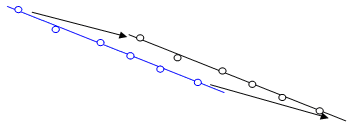
Buffer changes can shift the curve.
System preparation
Correct system preparation is necessary to ensure that the first analysis cycles (including the first correction curve) are reliable. Correct system preparation includes:
- Change all buffers or refresh the flow system according to the requirements of the run
- Run sensor chip conditioning and start-up cycles where appropriate
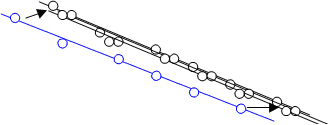
Inadequate system preparation can displace the first solvent correction curve.
The solvent correction points do not fall on the fitted line
The quality of the corrected results will never be better than the quality of the correction curve. The quality of the correction curve is indicated mainly by the Chi2 value of the fit. The acceptable error is dependent on the response level of the sample but preferably the Chi2 values should not exceed 2 RU2. Including blanks with different bulks is one way to test the quality of the correction procedure (corrected blank values should be close to zero regardless of the bulk contribution).
Old solvent correction solutions, a salt contaminated flow system and disturbed injections could all contribute to increased Chi2 values of the fit.
The first thing to do when the Chi2 values are high is to check the sensorgrams and exclude any cycles or correction points which are obviously disturbed.
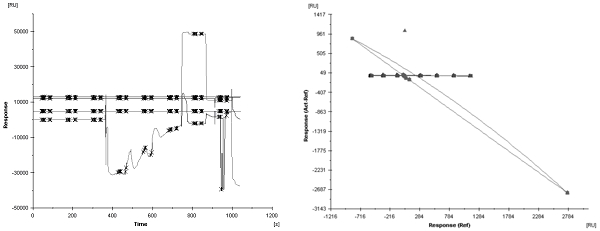
Air injection during solvent correction cycle (left) gives high scattering in solvent correction plot (right).
If the sensorgrams are acceptable but the fit is still poor, there may be errors in preparation of the solvent correction solutions. The exact DMSO concentration in theses solutions is not important, but it is essential that the bulk response is matched as carefully as possible in all other respects. Variations in e.g. salt concentration will contribute to fitting errors. If one or two points deviate consistently from the fitted curve, these can be excluded from the fitting.

Bad points can be excluded from the fitting.
Sample report point fall outside the correction interval
Match samples, solvent correction solutions and running buffer carefully with respect to salt concentration. Samples with large bulk shifts indicate errors in sample concentration or buffer preparation procedure. Make sure that the solvent correction solutions used cover a correction range of about -500 to +1000 RU and that the negative control samples lie within this range
Note that the solvent correction range depends on the differences between the running buffer and the solvent correction solutions, not on absolute DMSO concentrations.
At 5% DMSO in standard running buffer, an error of 0.5% in the DMSO concentration introduces a bulk shift of about 800 RU during the sample injection. When samples are diluted from stock solutions in 100% DMSO, errors of this order of magnitude can easily be introduced.
Extend the range of solvent correction solutions if individual samples lie outside the range in spite of careful sample preparation. The extrapolation option in the software should be used carefully, since the correction curve is usually not linear and extrapolation can be misleading:
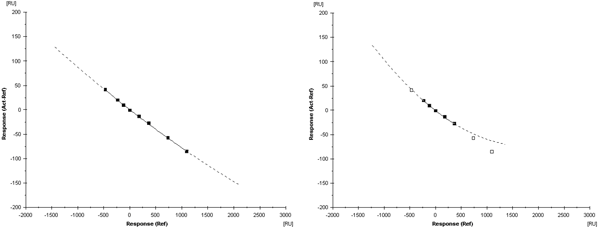
Illustration of the risks involved in extrapolating the solvent correction curve. Left: The correction curve extrapolated from the full set of measurements. Right: The same curve with the outermost points excluded from the fitting. The extrapolated curve is clearly incorrect.
Panel 2 header
Lorem ipsum dolor sit amet, consectetur adipisicing elit. Repellendus aliquid tempore natus voluptates repudiandae, eos dolorem libero inventore, quod incidunt, asperiores. Reiciendis itaque enim pariatur, blanditiis minima autem quo a nulla, obcaecati quis, excepturi atque ab rerum! Sequi molestias vel eum, hic, perspiciatis eius suscipit reprehenderit molestiae vitae similique.
Panel 3 header
Lorem ipsum dolor sit amet, consectetur adipisicing elit. Repellendus aliquid tempore natus voluptates repudiandae, eos dolorem libero inventore, quod incidunt, asperiores. Reiciendis itaque enim pariatur, blanditiis minima autem quo a nulla, obcaecati quis, excepturi atque ab rerum! Sequi molestias vel eum, hic, perspiciatis eius suscipit reprehenderit molestiae vitae similique.

Panel 4 header
Lorem ipsum dolor sit amet, consectetur adipisicing elit. Repellendus aliquid tempore natus voluptates repudiandae, eos dolorem libero inventore, quod incidunt, asperiores. Reiciendis itaque enim pariatur, blanditiis minima autem quo a nulla, obcaecati quis, excepturi atque ab rerum! Sequi molestias vel eum, hic, perspiciatis eius suscipit reprehenderit molestiae vitae similique.
Panel 4 header 2
Lorem ipsum dolor sit amet, consectetur adipisicing elit. Repellendus aliquid tempore natus voluptates repudiandae, eos dolorem libero inventore, quod incidunt, asperiores. Reiciendis itaque enim pariatur, blanditiis minima autem quo a nulla, obcaecati quis, excepturi atque ab rerum! Sequi molestias vel eum, hic, perspiciatis eius suscipit reprehenderit molestiae vitae similique.
Panel 5 header
Lorem ipsum dolor sit amet, consectetur adipisicing elit. Repellendus aliquid tempore natus voluptates repudiandae, eos dolorem libero inventore, quod incidunt, asperiores. Reiciendis itaque enim pariatur, blanditiis minima autem quo a nulla, obcaecati quis, excepturi atque ab rerum! Sequi molestias vel eum, hic, perspiciatis eius suscipit reprehenderit molestiae vitae similique.
Panel 5 header 2
Lorem ipsum dolor sit amet, consectetur adipisicing elit. Repellendus aliquid tempore natus voluptates repudiandae, eos dolorem libero inventore, quod incidunt, asperiores. Reiciendis itaque enim pariatur, blanditiis minima autem quo a nulla, obcaecati quis, excepturi atque ab rerum! Sequi molestias vel eum, hic, perspiciatis eius suscipit reprehenderit molestiae vitae similique.
Panel 5 header 3
Lorem ipsum dolor sit amet, consectetur adipisicing elit. Repellendus aliquid tempore natus voluptates repudiandae, eos dolorem libero inventore, quod incidunt, asperiores. Reiciendis itaque enim pariatur, blanditiis minima autem quo a nulla, obcaecati quis, excepturi atque ab rerum! Sequi molestias vel eum, hic, perspiciatis eius suscipit reprehenderit molestiae vitae similique.